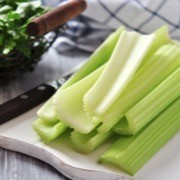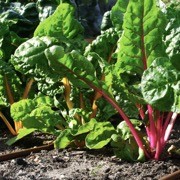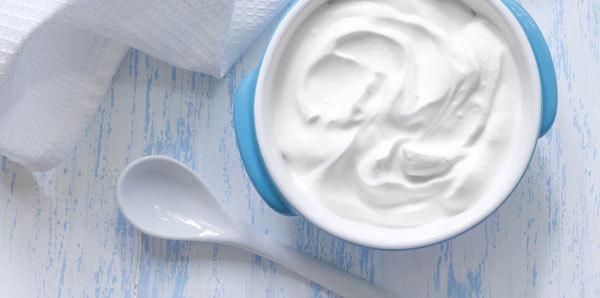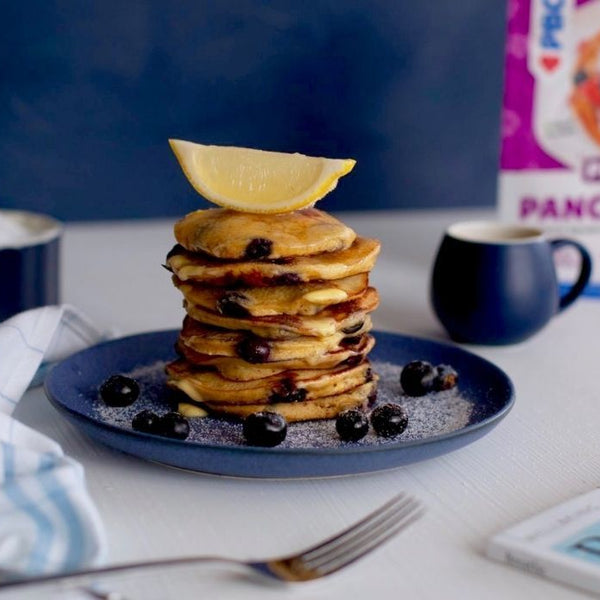
The 50 Lowest Carb Vegetables - The Definitive List
Have you just started off on your low-carb lifestyle and are wondering what vegetables are the best to eat? Or maybe you've been doing it for a while now and are looking for some inspiration and something a little different.
Check out our list of 50 vegetables with 5g of carbs or less per 100g in order from the highest carb, down to lowest.
You may notice the numbers overall are slightly lower than you see elsewhere on the Internet, or on apps such as MyFitnessPal. This is because the values we've listed below are the available carbohydrates per 100g, ie: not including soluble or insoluble fibre.
All values are per 100g of the raw product. I prefer raw vegetables where possible, or slightly blanched, but some (such as potato) shouldn't be eaten raw.
GREENS reign SUPREME!! But that old saying of 'Eat a Rainbow' is so important,as you can see below. Now before we get into it, keep in mind that it's easier to eat 200g of pumpkin for example than 200g of ginger, so keep things in perspective 🙂
If you have a few minutes, have a read through and look at the pretty pictures 🙂 you may just learn something new!
Update 5 July 2022: Updated for formatting and carbohydrate values.
#50 - #41
#40 - #31
 |
40. Leek - 3.3 gThese are such an under-rated food. They’re cheap to buy, contain a heap of great nutrients, taste amazing and are easy to cook with. What more could you want! Eaten raw or cooked. When you buy your leeks, make sure to give them a good wash as dirt can sometimes get into the inner leaves which might give your dish an unsatisfactory ‘crunch’ (speaking from experience). |
 |
39. Spaghetti Squash - 3.3 gYou tend to see this vegetable around on US Low carb websites as a "Low Carb Spaghetti" hack. This is because once cooked, the flesh breaks away into 'ribbons' or strands that look like spaghetti. Spaghetti squash contains many nutrients, including folic acid, potassium, vitamin A, and beta-carotene. |
 |
38. Bamboo Shoots - 3 gWhat can’t this amazing plant do! Bamboo is used for so many things around the world, around the house and in the kitchen! You’ve probably experienced the deliciousness of bamboo shoots in a stir-fry before, but they can be used in other dishes such as salads, or appetisers. Most commonly found in a small can in the tinned vegetable section of your local supermarket. They can also be purchased in some places fresh. Canned, it comes down to 1.6g |
 |
37. Celeriac - 2.8 gThis ugly looking vegetable is actually the edible rootstock from the celery plant! It has a mild, yet quite a distinctive flavour similar to celery (for obvious reasons) and parsley. Celeriac can be eaten raw in salads, or roasted, or even mashed as a low-carb replacement for mashed potato! |
 |
36. Red Cabbage - 2.7 gThis awesome vegetable is a staple of many Northern European countries. For me, it's associated with Christmas was this is when we'd get together with my Grandparents and have a traditional Danish feast. In Danish cooking, this pickled dish is called Rødkål. It has a very strong particular flavour which you'll either fall in love with straight away, or will grow on you (it took me a few years). If you're interested, check out the recipe for Rødkål here. |
 |
35. Green Beans - 2.7 gGreen beans are a delicious fresh snack, or can be used in a tonne of different dishes from salads, to stir fry’s, stews and more. They’re a good source of fibre and are high in Vitamin C too. A great healthy snack for the kids (or adults). Green beans are also known as string beans in the US – I’m not sure who’s name is more obvious! |
 |
34. Olives - 2.6 gThere are so many varieties of Olives, not to mention the stuffed kind you can find in the deli/ supermarket. 😍 Did you know that they were related to the stone fruit family? These are a great low carb snack if you are craving something salty and really add something special to your favourite pizza. Add chopped olives to your bolognese sauce, I promise you won't regret it! |
 |
33. Green Capsicum - 2.5 gGreen capsicums have the lowest carbs of the capsicum family (but only by 1g carb compared to red) Used in a stir-fry, or fresh in a salad, sliced on a pizza, or halved and stuffed with all sorts of good things, they’re a very welcome addition to any low-carb kitchen. |
 |
32. Patty-pan Squash - 2.5 gThese are a summer variety of squash and are an adorable small size and shape, looking like little flying saucers. Squashes can be used as a replacement for almost any recipe that calls for Zucchini as a way to mix things up. My favourite way to cook these little UFO’s is sautéed with a lot of butter and basil. Yummm! |
 |
31. Eggplant - 2.4 gThese beautiful dark vegetables are known as Aubergine in many parts of the world, or in many Asian countries as Brinjal. They're great sliced in a Moussaka, or cut in half lengthways, stuffed with whatever pleases you, covered in cheese and roasted in the oven. If you're entertaining, why not whip up some babaganoush. It's an amazing zip and is incredibly easy to make at home. |
#30 - #21
 |
30. Tomato (Roma) - 2.4 gThis particular variety of tomato is my favourite. Sweet, fragrant and delicious in so many ways. They’re slightly firmer than other varieties which means they’ll hold up well in sandwiches. They also taste amazing roasted! Like all tomato varieties, the Roma Tomato is incredibly low in carbohydrates. Whilst they might taste incredibly sweet, they contain very little sugar. |
 |
29. Kale - 2.3 gThe superfood poster-child of 2014 and favourite of beard-toting hipsters everywhere. This nutrient-dense leafy vegetable is very low in carbs and incredibly high in beta-carotene, vitamin K and vitamin C. It's also a good source of calcium and carotenoids. If you're still wondering how to make a delicious meal out of this vegetable, check out this great list of kale recipes on allrecipes.com |
 |
28. Savoy Cabbage - 2.3 gSavoy cabbage is the name of this particular variety of cabbage not to be confused with the widely available "green cabbage". The leaves have a very distinctive contrasty, rough look to them. Despite the appearance, the leaves are quite tender, even when eaten raw. They're a great choice for salads or blanched and used as a bed for rice or other dishes. Savoy cabbages are the sweetest and most tender variety of cabbage. |
 |
27. Yellow Wax Bean - 2.3 gAlso known as 'wax bean' or 'Butter bean' but not to be confused with the Butter Beans in a can. They are harvested young, are crisp, succulent and tender-firm, with mellow grassy sweet and nutty flavours. Use as you green beans. |
 |
26. Rocket - 2.2 gA delicious peppery salad vegetable. Rocket has a different name in almost all languages such as Rucoli, Rucola, colewort, Roquette (how fancy) and in the US, arugula. Typically eaten raw in salads, wraps and sandwiches, it can also be lightly steamed or tossed through pasta, risotto and frittata or served on top of a gourmet pizza. |
 |
25. Brussel sprouts - 2.1 gThe vegetable everyone loves to hate. Whilst these were probably forced upon you as a child and you've hated them ever since you really shouldn't. Brussels sprouts are really low in carbs and packed full of nutrients such as vitamin C and vitamin K, and moderate amounts of folic acid and vitamin B6. Whilst on their own they leave a lot to be desired for, sautéed in a fry pan with oodles of butter, garlic and even bacon, these little miniature cabbages really come into their own. If you haven't had these since you were a kid, it's probably time to give them another chance. |
 |
24. Hairy Melon - 2.0 gWhat a great name. So many puns and double entendres could be made here but I'll do my best to resist. Whilst technically a fruit, this is mostly used as a vegetable due to its flavour. It's sometimes called the Winter Melon or Ash Gourd. These fruits grow incredibly large and in all sorts of shapes. |
 |
23. Radish - 1.9 gRadishes are a crispy and peppery vegetable that are packed with Vitamins E, A, C, B6, and K. Plus it's high on antioxidants, fibre, zinc, potassium, phosphorous, magnesium, copper, calcium, iron and manganese. Almost like mini multivitamins. My favourite way to enjoy them is in a Fattoush Salad, however, they can be roasted and pickled. |
 |
22. Cauliflower - 1.9 gThese an amazingly under-rated vegetable. They're incredibly low in carbs despite having a rich creamy texture, and potato-like flavour. They're super delicious in a cheesy cauliflower bake, roasted and mashed as an incredible low-carb mashed potato-like dish or even used to make a Low Carb Fried Rice. The perfect winter vegetable. |
 |
21. Cucumber 1.9gKnown for being 90% water, the cucumber and are mostly used in salads. There are many varieties most common are the Lebanese and the Telegraph ones. They are crisp and refreshing. They can also be used in place of crackers with cheese, which is a great little low carb hack we use often. |
#20 - #11
 |
20. Zucchini Flowers - 1.9 gYou will find these in Meditteranean cooking mostly. The flower part of this vegetable is what is commonly stuffed with feta, ricotta, minced prawns etc. Baked or Fried. If you are new to this vegetable, check out the recipe for stuffed zucchini flowers with bacon, mushroom and ricotta 😍 |
 |
19. Cos Lettuce - 1.8 gAlso known as Romaine Lettuce, The Cos lettuce is long in shape. A sturdy leaf that can be used as a low carb taco shell. Its packed with vitamin C, vitamin K, and folate and a good source of beta-carotene. |
 |
18. Bean Sprouts - 1.6 gBean sprouts remind me of the delicious Asian dish Laksa, which is certainly not a bad thing! They’re really low in carbs and have an amazing fresh sweet flavour to them. Add them to your favourite salad for extra crunch! |
 |
17. Zucchini - 1.6 gThere are so many things you can do with the amazing low-carb vegetable that is the Zucchini! They can be sliced and grilled on the barbeque, grated and made into delicious low-carb fritters, or grated and hidden in Bolognese sauce to sneak them into your kid's meals. Did you know: Some varieties of Zucchini grow up to a meter in length! |
 |
16. Asparagus - 1.4 gThese are a fantastic vegetable for occasional accompanying many dishes. You can steam them, barbeque them, slice them and bake them! There's a tonne of reported health benefits from eating asparagus, such as healthier skin, regulation of blood sugar, and more. However you choose to enjoy them, just don't enjoy them too often. Asparagus is the only vegetable known to contain asparagusic acid which when broken down in the body, turn into sulfur-containing compounds, which don't smell the best! |
 |
15. Okra - 1.4 gAnother vegetable you’ve probably never heard of is the wonderful Okra. These are sometimes called colloquially as ‘ladies fingers’, or by region as bhindi, ochro, or gumbo (my favourite). They’re most widely used in the Middle East, the Caribbean, Southeast Asia and India. Okra, when cooked, release a glutinous substance (not gluten), which will help to thicken stews, curries or soups. When buying Okra, choose the smaller, younger pods with a vibrant green skin, no longer than 10cm. Still unsure? Check out these great Okra recipes from taste.com.au. |
 |
14. Artichoke Hearts - 1.3 gThe edible portion of this plant is actually the flower bulb before it’s flowered into fool bloom! They’re amazingly low in carbohydrates and pack a good amount of fibre and magnesium. I think they’re the best part of a nice antipasto platter or are amazing on a pizza too
|
 |
13. Celery - 1.2 gFamous for reportedly using more calories to digest than you get from eating this vegetable. Regardless of is this is fact or fiction, celery is a great addition to any diet. It's a great base for the start of many Bolognese recipes, can be added to a delicious Waldorf salad, or is great just covered in peanut butter and snacked on! |
 |
12. Silverbeet / Chard - 1.1 gThis Mediterranean vegetable is often confused with Rhubarb due to its brightly coloured stems. Make sure you don't make this mistake as they are two very different tasting plants! 100g of Silverbeet contains a whopping 120% of the recommended daily intake of Vitamin A, so if you're low, this is the way to go. This amazing plant also has a good solid punch of Vitamin C and Potassium. Basically, if you're not yet eating Silverbeet, you should! |
 |
11. Chinese Broccoli - 1.1 gA favourite of mine at Yum Cha smothered in oyster sauce, Chinese Broccoli is incredibly good for you thanks to its fibre content and nutrient dense foliage. There are so many ways to prepare Chinese Broccoli you could have it every day of the week and not get bored! How does Chinese Broccoli with Garlicky Ginger Miso sound :) |
#10 - #1
 |
10. Mignonette leaves - 1.1 gAlso known as butter lettuce, comes in a bronzy/ crimson and green colour. They have soft delicate leaves. Used where you would use any lettuce and bulk up your salads. |
 |
9. Chilli - 1.0 gUnless you’ve got an iron tongue or a penance for pain, I wouldn’t suggest using this one as the major vegetable in your dish. There are many different varieties of chilli’s ranging from ‘barely a tingle’, all the way through to ‘intolerably painful’. |
 |
8.Radicchio - 0.8 gRadicchio is also known as 'Chicory Lettuce' and is very popular in Italian salads. They have a bright 'wine' type colour. They can grow either long or round and' bulby'. These leaves are quite bitter but delicious. They can be char-grilled or simply chopped into your salads. |
 |
7. English Spinach - 0.7 gA favourite dish of Popeye’s, this leafy vegetable won’t turn you into the incredible hulk, but it is incredibly healthy! It’s extremely nutrient-dense and high in antioxidants, vitamins A, B2, C and K. It also has a good serve of magnesium, folate and potassium. It’s available all year round and is quite cheap to buy in bulk. Start packing some spinach into your diet! |
 |
6. Avocado - 0.6 gOne of my favourite vegetables (fruit) on this list, I love them so much I have written another whole blog about why avocados are amazing, check it out here. The sound of the word avocado makes me happy, not as happy as cutting into the perfect avocado though. There’s not much that beats that! Guacamole, on toast, in pasta, on steak, in salads, there’s almost no bad way to have an avocado! They pack a good hit of calories due to their high-fat content but are really low in carbs so are a great addition to your HPLC or HPHF diet. |
 |
5. Bok Choy - 0.6 gWhat’s a stir-fry without Bok Choy! This vegetable is also known as Chinese Cabbage and makes an absolutely delicious addition to any stir fry and is a great way to get more of that delicious stir-fry flavours into your mouth at once. It’s a very light textured and flavoured vegetable due to its high water content. That doesn’t mean it’s not high in nutrients though, with a good dose of Vitamin A and Vitamin C. |
 |
4. Alfalfa Sprouts - 0.5 gThese are the young shoots of the alfalfa plant, picked before they continue to grow. Because of their small size, they’re condensed full of certain minerals and vitamins. They’re probably one of my favourite things to add to a salad sandwich giving it a deliciously fresh, slightly nutty flavour. |
 |
3. Broccoli - 0.4 gThe staple of body-builders all across the world, and for good reason! This amazing vegetable is delicious, nutritious, and super low carb. It’s almost always in my fridge ready to add to any dish that needs some green added to it. Hot Tip: If your broccoli is looking a little sad and wilted, don’t throw it away, chop it up into pieces and put it in a bowl of iced water and in the fridge for half an hour or so. It will come out looking better than the day you bought it! Looking for a different way to eat those greens? Check out our delicious Low Carb Cheesy, Broccoli & Bacon Savoury Muffin recipe here. |
 |
2. Curly Endive - 0.4 gYou will probably recognise this mixed in your '4 leaves' bags of mixed lettuce in your supermarket. However this a popular vegetable in Italian cooking too. It is also part of the Chicory family. If you are new to this one, check out a recipe that features this vegetable cooked or simply start by popping it in salads. |
 |
1. Mushroom - 0.3 gThese are a wonderful addition to so many dishes, or as the feature of the dish itself. Eaten raw or cooked, you’ll never get bored with finding new ways to eat mushrooms. They’re a great food to incorporate into your diet if you’re avoiding carbs due to their incredibly low carbohydrate content. Mushrooms come in so many different varieties of all shapes and sizes, but play it safe and buy them from a shop as many wild mushrooms are extremely poisonous but can look really similar to safe, edible mushrooms. |
Need a quicker way of selecting your low-carb vegetables?
Shortcut #1 – Lighter or Darker?
You may have noticed, that as a general rule of thumb, the darker and greener the vegetable (spinach, rocket, kale), the less carbs it has, whilst the whiter and lighter (potato, carrot, squash) the more carbs it has. This rule doesn't work for all vegetables, but can help you make a quick educated decision if you're at the shops and can't look it up. Also, most lettuces - Iceberg, Cos, and all salad greens are super low in carbs. We may not have listed ALL of them, but enjoy them without worrying 😍Shortcut #2 – Above ground or below ground?
Our second shortcut to figure out if a vegetable is low-carb or not, is to ask yourself "what part of the plant is this?". Looking at a plant from top to bottom, the lowest carb part of the plant is generally at the top, namely the leaves and stems, whilst as you work your way down the plant, you get higher in carbs, until you get to the highest-carb part of the plant which is generally the roots of the plant, like potatoes, carrots, etc. So what about flowers & fruits? Well most edible flowers are quite low in carb and delicious (think stuffed Zucchini flowers). Meanwhile, fruits range from super low-carb like Raspberries and Cranberries, up to super high-carbs such as Oranges, Mango and Grapes, so make sure you do your research before you go to town on the fruit section at the local deli. We'll be doing an article on that shortly so stay tuned.
Interested in low carb, learn more...
 |
20 Low Carb Fruits - The Definitive ListLooking for a list of low carb fruit? Or want to know the carbs in your favourite fruit, this this blog is for you |
Sources: All the nutritional information for this article was sourced from the nutrition data provided by the Food Standards Australia food nutrient database found here:
href="https://www.foodstandards.gov.au/science/monitoringnutrients/afcd/Pages/default.aspx">https://www.foodstandards.gov.au/science/monitoringnutrients/afcd/Pages/default.aspx
In doing research for this article, I did notice some minor discrepancies and fluctuations on some of the items. There were all relatively minor and could be put down to seasonal and geographical available varieties of the vegetable plants listed.
Feature Image: Original by Denish C via Flickr













